

Modeling With Mathematics. Modeling with mathematics is the practice of making sense of the world through a mathematical perspective.

Take a moment to look around and get curious: How do you use mathematics to make decisions in your everyday life? Maybe you’re deciding what to make for dinner. Does the recipe have enough servings to feed everyone or will you need to modify it, perhaps by doubling or halving the amount of each ingredient? When should you start making dinner if you’d like to eat at 6? These questions can be viewed from a mathematical perspective. Children also need opportunities to identify mathematical problems in their world, determine what information will help them solve a problem, develop mathematical models of situations, and revise their models to more closely predict real world phenomena.
An Important Teacher Decision: When and When Not to Give the Answer? The fourth graders I’ve been working with this year have recently been learning about fractions.

Last week I began a lesson by drawing two representations on the board (as shown above) and writing a question. I gave the students about five minutes to do a “quick write” to answer the question and explain their thinking. I collected their papers without commenting on them, and then I began the discussion. The conversation lasted for about 45 minutes, and a variety of arguments emerged. It was obvious to some students that the blue representation was 5/4, but others weren’t sure about that. It was fascinating. Some students changed their thinking during the discussion, a few more than one time. Ending the Discussion Math class is the hour before lunch, and after the conversation had gone on for almost 45 minutes, one boy announced, “I’m tired and I’m hungry.”
Then, to get a sense of where the students were in their thinking, I asked them to put their heads down so they could vote privately. Archives of Weekly Challenges - SUMMER MATH PHOTO CHALLENGE 2015. Archives of Weekly Challenges - SUMMER MATH PHOTO CHALLENGE 2015. Alyssa and India.. Productive struggle and aha moment. Powerful Problem Solving by Max Ray-Riek. Max has distilled the Math Forum's years of experience, thousands of hours of classroom observation, and abundant creativity into a brisk book full of practice and theory.
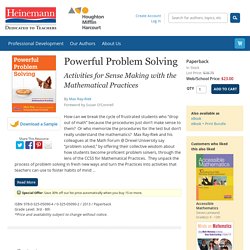
—Dan Meyer, international speaker on mathematics education and one of Tech & Learning’s “30 Leaders of the Future” Max Ray and his Math Forum colleagues have crafted a powerful guide to bringing the Standards for Mathematics Practice to life in our classrooms. Packed with real classroom experiences and easy-to-adopt activities, this book will help every teacher of mathematics overcome the instructional obstacles we face when trying to engage students in problem solving, reasoning and communication.
—Steve Leinwand, American Institutes for Research and author of Accessible Mathematics Powerful Problem Solving draws attention to a greater understanding of how to integrate the Standards for Mathematical Practice into daily teaching to ensure that students develop critical thinking and problem solving skills. Dan Meyer 3 Acts for 6 Courses. Real World Math for Common Core and Ontario Curriculum The following list of 3 Acts Real World Math Problems for Grade 6 Mathematics in Ontario.
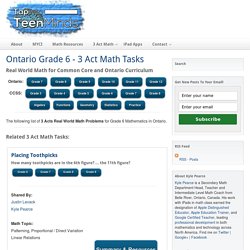
Preparing Students For Fraction Multiplication. 1st Grade Story Problems. Tomorrow I go into a 1st grade classroom to teach a lesson on addition and subtraction story problems.
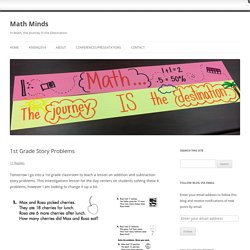
This Investigations lesson for the day centers on students solving these 6 problems, however I am looking to change it up a bit. While reading my CGI book, Children’s Mathematics, to learn more about the trajectory in which students solve these types of problems, I found this diagram really helpful and interesting…. I went into this planning thinking I was going to be looking for how students combined numbers in the context of the diagram above. From there, I was planning to have students do a structured share of their strategies, comparing and contrasting along the way. However, as I got ideas from Jamie (@JamieDunc3) on Twitter, I started to think how much more I would learn about their thinking in talking about their noticings, wonderings, and number choices.
So…I took the second question, removed the actual question and made it a notice/wonder: ~Kristin. POTWB 15 ME DP 07 P. 1001 Math Problems. Drafter%27s+puzzle+%28easy%29.jpg (JPEG Image, 1343 × 1600 pixels) - Scaled (62%) SolveMe Mobiles. The+Flattened+Polyhedron+Problem.jpg (JPEG Image, 1600 × 1440 pixels) - Scaled (64%) Another+Handshake+Problem+copy.jpg (JPEG Image, 1600 × 1200 pixels) - Scaled (64%) Questioning My Metacognition. Check out Dan’s Blog or watch Math Class Needs a Makeover ***click here for the question and big idea of each task ***

Museum+problem.jpg (JPEG Image, 1427 × 1600 pixels) - Scaled (62%) Place+symbols+in+order.jpg (JPEG Image, 1280 × 1600 pixels) - Scaled (62%) Decorated+cube.jpg (JPEG Image, 1125 × 1600 pixels) - Scaled (62%) Origami+square+problem.jpg (JPEG Image, 1100 × 1300 pixels) - Scaled (77%) Relief Teaching Ideas. A game for 2 or 3 players.
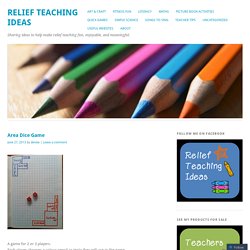
Each player chooses a colour pencil or texta they will use in the game. Players take turns rolling the dice, using the numbers that they rolled to draw the perimeter of a rectangle or square & writing the area in the middle of the shape. Game ends when players run out of room to draw. Winner is the player who has used the largest area/most squares. This game is an old favourite. Like this: Painting Youcubed - Generalization, Number Sense, Pattern Recognition, Shape and Space.
Students build and draw three-dimensional cubes made up of small unit cubes.
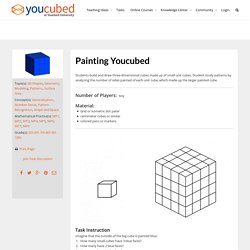
Student study patterns by analyzing the number of sides painted of each unit cube, which made up the larger painted cube. Number of Players: Any Material:Grid or isometric dot patercentimeter cubes or similarcolored pens or markers Task Instruction Imagine that the outside of the big cube is painted blue.How many small cubes have 3 blue faces? Un Jour Un Jeu: une idée d'animation par jour. La Princesse du château d’à côté à perdu ses 5 sens, ce qui est bien malheureux car, sans, elle ne pourra pas épouser le prince charmant.
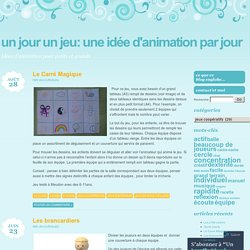
Heureusement, elle peut compter sur l’aide de pleins de petits débrouillards qui vont l’aider à retrouver ses sens. Ce grand jeu se déroule par petites équipes, chacune mené par un animateur qui les dirige de stand en stand. Stand n°1: Le toucher -> Dans un grand sac noir ranger toutes sortes d’objets ( éponge, brosse à dent, chaussette, foin..) et demander à chaque joueur de l’équipe d’y plonger la main, tour à tour. Pour récolter le point les joueurs de l’équipe doivent reconnaître le maximum d’objets rien qu’en les touchant. Stand n°2: Le goût -> Sous une bassine, cacher des aliments/boissons reconnaissables facilement (confiture, nutella, pâte d’amande, vinaigre, ketchup, chocolat..). Shaded%2Btriangle%2Bproblem. Stacked+dice+problem+copy.jpg (JPEG Image, 1600 × 1092 pixels) - Scaled (64%)
Toothpick+perimeter+problem.jpg (JPEG Image, 1415 × 1600 pixels) - Scaled (62%) How+many+toothpicks?.jpg (JPEG Image, 1600 × 1588 pixels) - Scaled (63%) Two+mangoes+problem.jpg (JPEG Image, 1600 × 1600 pixels) - Scaled (62%) The+Fish+Problem.jpg (1300×1600) Que faire avec ceci? - Community. 1001 Math Problems.